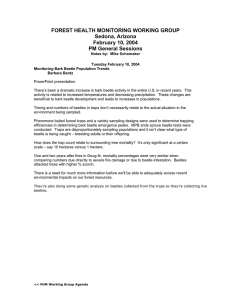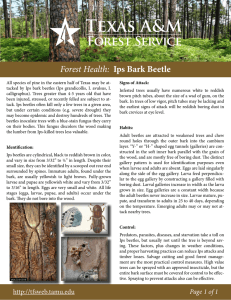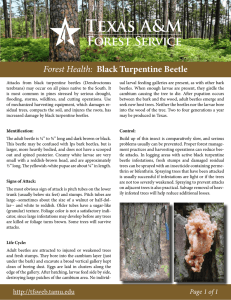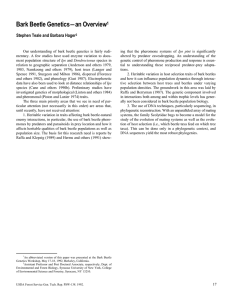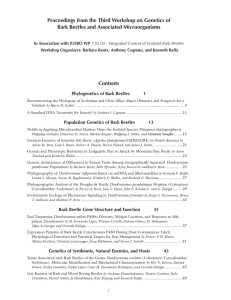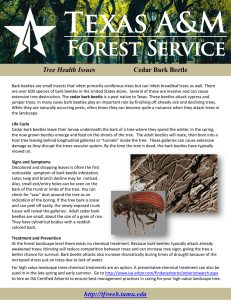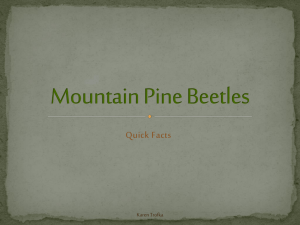Conifer Bark Beetles
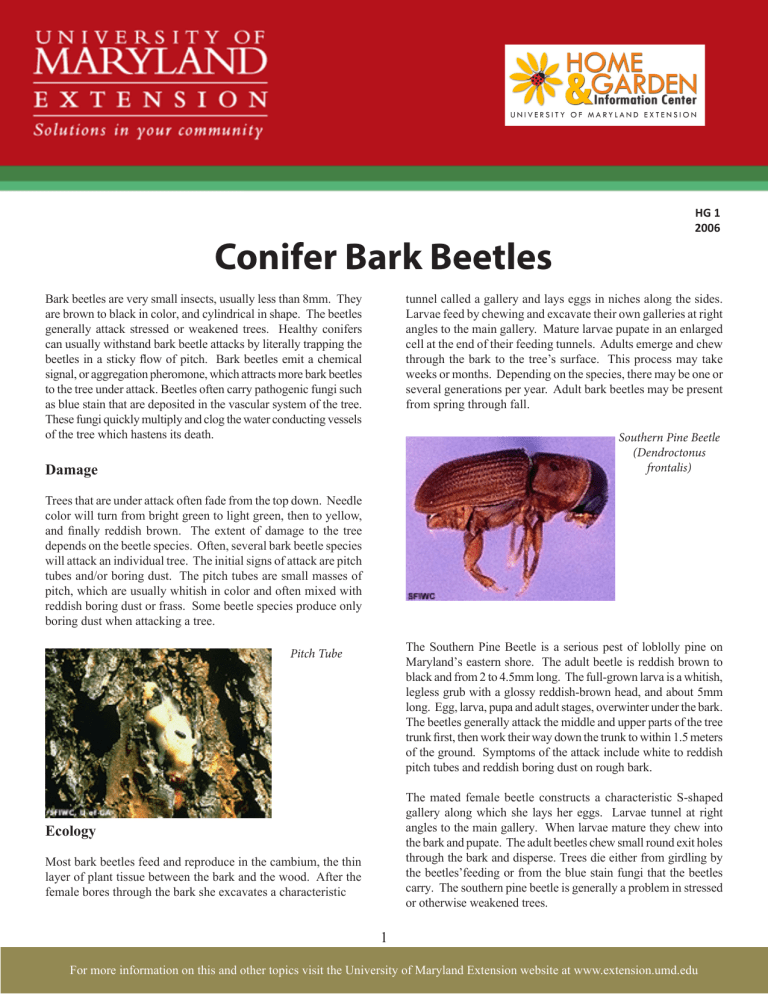
Damage
HG 1
2006
Conifer Bark Beetles
Bark beetles are very small insects, usually less than 8mm. They are brown to black in color, and cylindrical in shape. The beetles generally attack stressed or weakened trees. Healthy conifers can usually withstand bark beetle attacks by literally trapping the beetles in a sticky flow of pitch. Bark beetles emit a chemical signal, or aggregation pheromone, which attracts more bark beetles to the tree under attack. Beetles often carry pathogenic fungi such as blue stain that are deposited in the vascular system of the tree.
These fungi quickly multiply and clog the water conducting vessels of the tree which hastens its death.
tunnel called a gallery and lays eggs in niches along the sides.
Larvae feed by chewing and excavate their own galleries at right angles to the main gallery. Mature larvae pupate in an enlarged cell at the end of their feeding tunnels. Adults emerge and chew through the bark to the tree’s surface. This process may take weeks or months. Depending on the species, there may be one or several generations per year. Adult bark beetles may be present from spring through fall.
Southern Pine Beetle
(Dendroctonus frontalis)
Trees that are under attack often fade from the top down. Needle color will turn from bright green to light green, then to yellow, and finally reddish brown. The extent of damage to the tree depends on the beetle species. Often, several bark beetle species will attack an individual tree. The initial signs of attack are pitch tubes and/or boring dust. The pitch tubes are small masses of pitch, which are usually whitish in color and often mixed with reddish boring dust or frass. Some beetle species produce only boring dust when attacking a tree.
Pitch Tube
Ecology
Most bark beetles feed and reproduce in the cambium, the thin layer of plant tissue between the bark and the wood. After the female bores through the bark she excavates a characteristic
The Southern Pine Beetle is a serious pest of loblolly pine on
Maryland’s eastern shore. The adult beetle is reddish brown to black and from 2 to 4.5mm long. The full-grown larva is a whitish, legless grub with a glossy reddish-brown head, and about 5mm long. Egg, larva, pupa and adult stages, overwinter under the bark.
The beetles generally attack the middle and upper parts of the tree trunk first, then work their way down the trunk to within 1.5 meters of the ground. Symptoms of the attack include white to reddish pitch tubes and reddish boring dust on rough bark.
The mated female beetle constructs a characteristic S-shaped gallery along which she lays her eggs. Larvae tunnel at right angles to the main gallery. When larvae mature they chew into the bark and pupate. The adult beetles chew small round exit holes through the bark and disperse. Trees die either from girdling by the beetles’feeding or from the blue stain fungi that the beetles carry. The southern pine beetle is generally a problem in stressed or otherwise weakened trees.
1
For more information on this and other topics visit the University of Maryland Extension website at www.extension.umd.edu
Ips, Engraver Beetles
( Ips avulsus, I. grandicollis , and
I. calligraphus )
Black Turpentine Beetle
( Dendroctonus terebrans )
The Ips, or Engraver Beetles are more common on the western shore and in central Maryland on various conifers, particularly white pine. There are several Ips species that occur in Maryland
( Ips avulsus, I. grandicollis , and I. calligraphus ). The larvae of all Ips are very similar: white legless grubs, several millimeters in length, with brown heads. Ips avulsus is called the small southern pine engraver. The adult is reddish brown to black,
2.5mm in length. It prefers the upper limbs and tops of pines. Adult beetles are attracted to freshly cut or otherwise injured trees, including trees injured by other bark beetles. Ips grandicollis , the southern pine engraver, also prefers to attack the upper portions of pines, but is frequently found in fallen trees. The adult is reddish brown to black and 3-4.5mm long.
Ips calligraphus , the six-spined engraver, is reddish brown to black and 3.5-6.5mm long. It is different from the other Ips species in that it tends to attack the lower portion of the trunk of most pine species.
The Black Turpentine Beetle is the predominant bark beetle in western Maryland. It is the largest bark beetle in North America.
The adult is dark reddish-brown to black, and 5-10mm long. Fully grown larvae are creamy white, legless, about 12mm long, with shiny reddish-brown heads. Black turpentine beetles generally confine attacks to the bottom 2 meters of the trunk. They particularly like stumps of freshly cut trees. Galleries of adult beetles and larvae may be very large, 30 centimeters or more across. Characteristic injury symptoms include large whitish to reddish pitch tubes and bark pellets in the bark crevices or at the base of the tree. Infested trees are almost always secondarily attacked by ambrosia beetles, which produce fine white sawdust at the base of the tree.
Control
The best control for bark beetles is prevention. Healthy trees are able to withstand most bark beetle attacks. Insecticidal sprays will not kill the beetles or larvae inside the tree and sprays will not reverse the damage that has already occurred. Trees should receive adequate water in times of summer drought. Dead or dying trees should be removed to eliminate breeding sites for additional beetle generations. If the trees are to be used for firewood strip the bark, and/or tarp the logs with the bark left on. Sprayed logs should not be used for fire wood. Many trees, especially white pines, succumb to bark beetle attack during drought years. Trees that are infested but not yet showing symptoms, will probably die the following year.
2
Protect Bay
Use Pesticides and Fertilizers Wisely
USE INSECTICIDES WITH CARE. READ THE LABEL
DIRECTIONS.
FOLLOW ALL SAFETY PRECAUTIONS.
Mention of trade names does not constitute an endorsement by University of
Maryland Extension
Do you have a plant or insect pest question?
Visit us at extension.umd.edu/hgic and click Ask Maryland’s Garden Experts
Author: Mary Kay Malinoski, University of Maryland Extension Specialist, Home and
Garden Information Center
This publication is a series of publications of the University of Maryland Extension and The Home and Garden Information Center. For more information on related publications and programs, http://extension.umd.edu/hgic. Please visit http://extension.umd.edu/ to find out more about Extension programs in Maryland.
The University of Maryland, College of Agriculture and Natural Resources programs are open to all and will not discriminate against anyone because of race, age, sex, color, sexual orientation, physical or mental disability, religion, ancestry, or national origin, marital status, genetic information, or political affiliation, or gender identity and expression.
3
For more information on this and other topics visit the University of Maryland Extension website at http://extension.umd.edu

